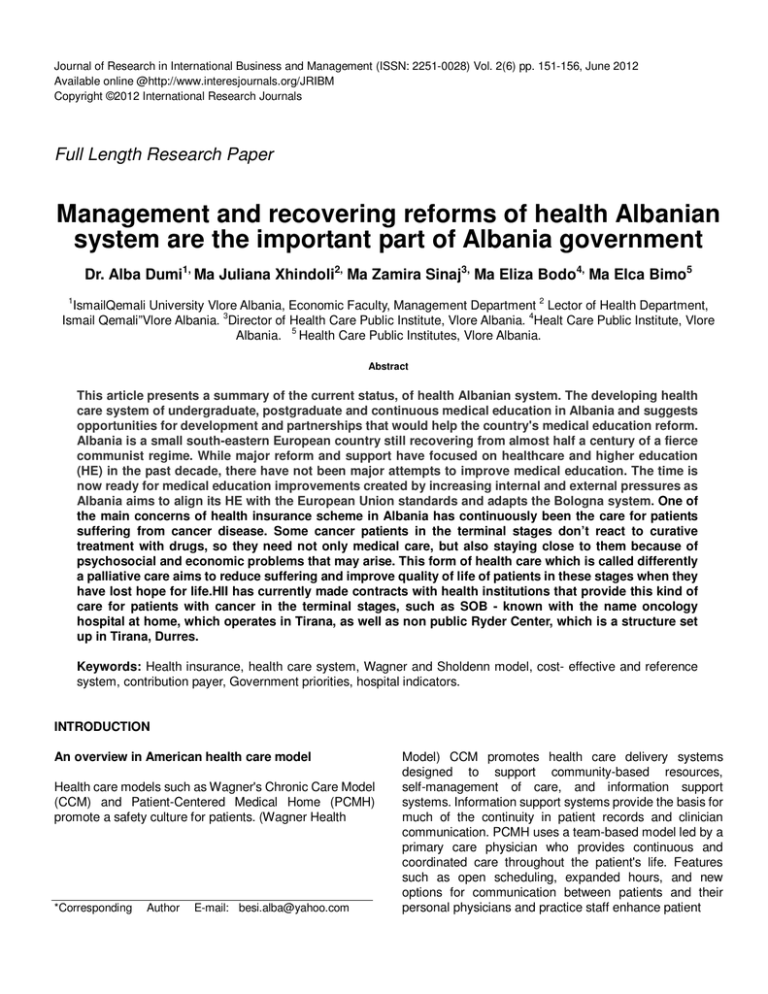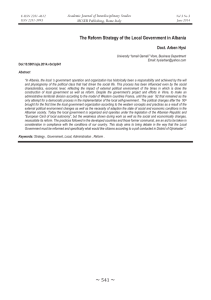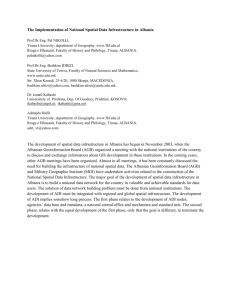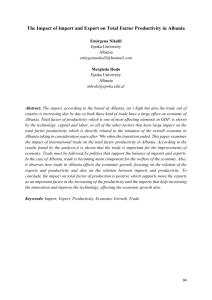Document 14249135
advertisement

Journal of Research in International Business and Management (ISSN: 2251-0028) Vol. 2(6) pp. 151-156, June 2012 Available online @http://www.interesjournals.org/JRIBM Copyright ©2012 International Research Journals Full Length Research Paper Management and recovering reforms of health Albanian system are the important part of Albania government Dr. Alba Dumi1, Ma Juliana Xhindoli2, Ma Zamira Sinaj3, Ma Eliza Bodo4, Ma Elca Bimo5 1 IsmailQemali University Vlore Albania, Economic Faculty, Management Department 2 Lector of Health Department, Ismail Qemali”Vlore Albania. 3Director of Health Care Public Institute, Vlore Albania. 4Healt Care Public Institute, Vlore Albania. 5 Health Care Public Institutes, Vlore Albania. Abstract This article presents a summary of the current status, of health Albanian system. The developing health care system of undergraduate, postgraduate and continuous medical education in Albania and suggests opportunities for development and partnerships that would help the country's medical education reform. Albania is a small south-eastern European country still recovering from almost half a century of a fierce communist regime. While major reform and support have focused on healthcare and higher education (HE) in the past decade, there have not been major attempts to improve medical education. The time is now ready for medical education improvements created by increasing internal and external pressures as Albania aims to align its HE with the European Union standards and adapts the Bologna system. One of the main concerns of health insurance scheme in Albania has continuously been the care for patients suffering from cancer disease. Some cancer patients in the terminal stages don’t react to curative treatment with drugs, so they need not only medical care, but also staying close to them because of psychosocial and economic problems that may arise. This form of health care which is called differently a palliative care aims to reduce suffering and improve quality of life of patients in these stages when they have lost hope for life.HII has currently made contracts with health institutions that provide this kind of care for patients with cancer in the terminal stages, such as SOB - known with the name oncology hospital at home, which operates in Tirana, as well as non public Ryder Center, which is a structure set up in Tirana, Durres. Keywords: Health insurance, health care system, Wagner and Sholdenn model, cost- effective and reference system, contribution payer, Government priorities, hospital indicators. INTRODUCTION An overview in American health care model Health care models such as Wagner's Chronic Care Model (CCM) and Patient-Centered Medical Home (PCMH) promote a safety culture for patients. (Wagner Health *Corresponding Author E-mail: besi.alba@yahoo.com Model) CCM promotes health care delivery systems designed to support community-based resources, self-management of care, and information support systems. Information support systems provide the basis for much of the continuity in patient records and clinician communication. PCMH uses a team-based model led by a primary care physician who provides continuous and coordinated care throughout the patient's life. Features such as open scheduling, expanded hours, and new options for communication between patients and their personal physicians and practice staff enhance patient 152 J. Res. Int. Bus. Manag. experiences and improve the quality of care. (Wagner and Sholdenn, year 2011)A well-integrated, culturally competent health care delivery system that allows patient information to be readily available to providers positively affects the quality and efficiency of care and therefore patient outcomes. The adoption and use of health information technology (IT) can be an effective way to manage health care costs and improve the quality of care. Since the publication of the Institute of Medicine (IOM) report Unequal Treatment: Confronting Racial and Ethnic Disparities in Healthcare, which emphasized the need for standardized collection and reporting of racial and ethnic data, the need for more granular detail on racial and ethnic subgroups has become apparent. This is an area where the adoption and use of health IT can be beneficial. Albanian partnership programs and modifications medical The impact of these changes and developing health care sector in Albania may be reduced by two modifications in undergraduate medical programs. First identifying, training practice discrepancies, with a view of correcting them. Computerization of all pharmacies started for the first time in 2007. Partnership with health institutions and namely with pharmacies was also strengthened. The intention of this corporation was to insure hardware equipment to support the software produced by HII. Since their system was designed in such a way that it served not only to HII, but also to pharmacies in their everybody work, very soon pharmacists that previously didn’t want to procure equipment became our collaborators in improving the system. The HII received more than 17% of all health funds, with 8.5% coming from the state budget, 4.3% from employers and 4.4% from individual contributions. While the state remains the major source of health care financing, its contribution shrank from around 84% in 1990 to less than 60% in 1999 as other funding, especially out-of-pocket payments, increased. Changes made in the new contract will improve the quality of the service deliverance, will make planning and drugs administration more efficient, improve exchange of information and strengthen the controlling role via execution of sanctions. The contract has reflected all legal amendments as follows: 1.There is improvements in the way of keeping files on emergency, imagery, laboratory services (usage of the new form, which provides guides to the patients to address to the relevant service for carrying out examinations). 2.The clinical record is now unified with the basic register, something that enables the patient identification at all stages of the hospital services delivery (from admission into emergency division up to all the hospitalization service).Healthcare is funded by the state and private practice is limited to a small niche sector. The state system is supposed to be funded through insurance contributions from those employed and their employers, but poverty in Albania is rife and few can afford to pay. The net result is that many people fail to get much needed medicine and medical care to treat their ailments. The failure to collect a substantial amount of contributions means that healthcare system is strongly reliant on charitable aid for medical supplies and drugs: The National Strategy for Socio-Economic Development (NSSED), Hoering (2002) and Deutsche fur international Albania health reforming Health care seeks to prevent, diagnose, and treat disease and to improve the physical and mental well-being of all Americans. Across the lifespan, health care helps people stay healthy, recover from illness, live with chronic disease or disability, and cope with death and dying. Quality health care delivers these services in ways that are safe, timely, patient centered, efficient, and equitable. Unfortunately, Americans too often do not receive care that they need, or they receive care that causes harm. Care can be delivered too late or without full consideration of a patient's preferences and values: ISKSH Focus Magazine nr 2010, 2011 and MOH Report year 2011. Literature Review and Hypotheses Management functions require urgent attention, and Albania does not have any professional management consultants. Managerial performance is judged more by political commitment than by effectiveness. Most funding is determined centrally by comprehensive budgets that are allocated at the start of each financial year. District administrators and health care managers have little flexibility and limited technical capacity to manage effectively. Other significant achievements in the primary health care sector are improvements with regard to relations between the medical staff and HC-s heads, transparency in decision making and budget spending and communication at all levels. All these are due to advantages of decentralization of the health system in primary heath care sector. There is also an urgent need to establish management information systems, which would provide useful and accurate program and budgeting information: MOH analyze international conference, 2010, 2011 and MOF , USAID Financial report 2011.Other stakeholder groups, such as professional associations, unions and consumer groups, play little role in planning or regulation. Health service providers are still not accountable to their patients, despite the policy objective of the Ministry of Health to “put Dumi et al. the patient at the centre of the system”. Decentralization of the health care system The financial contracts between HII and health centers were bided based on an established traditional process, consisting in a close cooperation with all stakeholders contributing in the primary health care. The process commenced with getting the opinions of all HIRD-s and health centers that have made contracts with these directories and as well as the viewpoints of other stakeholders in the health sector: Ministry of Health (Department of Public Health), Order of Physicians, Order of Nursing, associations and health services unions. The problems identified during monitoring and control of contract implementation during fiscal year 2011 served also as a source of information for improving the contract. During the process of developing 2012 contract with primary health care centers, a special attention was paid to elements that affect the consolidation of health center management, as a public entity responsible for serving the population that is registered next to it The health care system in Albania remains highly centralized and hierarchical, despite some decentralization. Some administrative responsibility (but no political or policy responsibility) has devolved to the 36 districts, though they remain accountable to the Ministry of Health. Responsibility for running and maintaining rural PHC facilities has largely devolved to the local governments. Rural PHC doctors primarily use these facilities but receive their salaries, based on capitation fees, from the Health Care System in Albania: Theodorakis et al., 2000, Workshop on research of general practice in transitional environment. Zagreb, 2000 and Theodorakis et al., 2000. Which are the categories that benefit from health insurance scheme? Source: ISKSH Albania, year 2009, Focus Journal All citizens of the Republic of Albania benefit from health insurance schemes, whether contributory or vulnerable categories, since the state contributes for the later. The contract emphasis the increase of the healthcare quality provided to the patients, through building capacities of health care personnel. This will be achieved by the physicians’ active participation in the system of Continuous Medical Education, as one of the priorities of HII funding policies. Another way of improving the health services quality is the financial motivation of health personnel based on everyone’s performance and contribution. The rewards to medical staff shall not be the 153 similar for those that work and contribute for good achievements of the institution and those that don’t work and take care for their own comfort only. HC 2012 contract can be considered as such that consolidates management position of health center directors as well as accountability of all actors who are part of this contract. Four years have passed since the reform in the health care sector started in January 2007. During this period, the following significant steps have been undertaken by HII with the intention to consolidate the primary health care service: 1. A health services package, which created the premises for the provision of a standard health care to all residents, was developed in the primary health care sector. 2. A supportive supervision was carried out in primary health care during 2009-2010, something that enabled an accurate measurement of the discrepancies between actual and expected level of health services provided by HC management and their addressing in due time, in order to improve the quality, performance and efficiency of health services. Which are the benefits from the health insurances? The entire population benefits health services free of charge through health insurances; free of charge service by the family doctor; specialist doctors; free of charge health services at home, from polyclinics and hospital; free of charge laboratory and radiological examinations; unique tertiary examinations with a 90% reimbursement by the HII and 10 % with the patient co-payment; free of charge drugs from the reimbursed drugs list for children 0-12 months, invalids, pensioners, blind and orphans; free of charge drugs for veterans with chronic disease and war invalids; patients with tumors, kidney transplantation, multiple sclerosis and major CA. ISSH International J.2010, ISKSH Vlore analyze, A Dumi analyze year 2009, ISKSH Tirana Albania Focus Journal, 2011. H 1.Two competing models: 1. (Bismark and Beverage), 2. (Mogediss and Creblenn) was based on insurances health care system in Albania. Is the actual model the best one for Albania and why? Health services in Albania and health indicators 36 % of the interviewed patients were over 60 years old and 36% were 41 - 59 years old. It came out from this interviews that people over 41 years old, about 72%, were the greatest users of the health services in primary health care, as this is the most vulnerable age of the population. Concerning the category of people suffering from ‘chronic’ 154 J. Res. Int. Bus. Manag. Table1. Health care financing (level 1), state budget (level 2), individual contribution (level 3) Table 2. The data for diagnose, reimbursement funds in Albania, ISKSH publishing data, year 2011 Source: ISKSH Albania DIAGNOSES TABLE I. TABLE II. NO. OF PATIENTS ESSENTIAL TABLE V. TABLE III. NO. OF TABLE IV. REIMBURSEMENT (IN LEKE) PRESCRIPTIONS TABLE VI. 182,317 TABLE VII. 786,659 TABLE VIII. 762,024,922 TABLE X. 47,697 TABLE XI. 215,581 TABLE XII. 441,484,544 TABLE XIV. 283 TABLE XV. 1,257 TABLE XVI. 294,618,695 TABLE XVIII. 2,213 TABLE XIX. 9,225 TABLE XX. 269,883,549 TABLE XXII. 18,718 TABLE XXIII. 70,131 TABLE XXVI. 22,729 TABLE XXVII. HYPERTENSION TABLE IX. DIABETIS - MELITUS TABLE XIII. THALASEMIA- MAJOR TABLE XVII. KIDNEY CHRONIC INSUFFICIENCY TABLE XXI. BRONCHIAL ASTHMA TABLE XXV. CARDIAC 93,210 INSUFFICIENCY TABLE XXIX. MYELOID LEUKEMIA TABLE XXIV. 251,777,024 TABLE XXVIII. 162,277,45 4 TABLE XXX. 222 TABLE XXXI. 570 152,462,38 TABLE XXXII. 1 TABLE XXXIII. SCHIZOPHRENIC TABLE XXXIV. 9,324 TABLE XXXV. 39,358 PSYCHOSIS TABLE XXXVII. EPILEPSY TABLE XXXVI. 152,398,32 7 TABLE XXXVIII. 9,333 and ‘acute’ diseases, 65% of interviewed patients were suffering from chronic diseases and 35% were patients suffering from acute diseases. H 2.The important problem facing the government after the transition to multiparty democracy in 1992 was finding the financial resources to maintain essential health services, given the very small government budget. What changes are introduced in the health insurance scheme in recent years? Management functions require urgent attention, and Albania does not have any professional management TABLE XXXIX. 41,014 TABLE XL. 124,582,444 consultants. Managerial performance is judged more by political commitment than by effectiveness. Most funding is determined centrally by comprehensive budgets that are allocated at the start of each financial year. District administrators and health care managers have little flexibility and limited technical capacity to manage effectively. H3. Under such a situation, it is necessary to organize continuous training of the medical personnel, in order to promote their capacities for giving advices to their patients, based on the principle that “the patient stands at the Dumi et al. center of all”. It is evident that the patient-nurses relations have been improved if compared with the previous study and so the relations between doctors and patients (47.8% of the patients assess these relations as very well in 2010 compared with 20% in 2008). We think that this is due to the fact that the current funding contracts differently from the previous contracts made between HII and health centers describe all the duties and obligations of the nursing staff. Albanian health services are funded through a mix of taxation and statutory insurance. (Source: MOH government report 1992-1999)(Table 1) Businesses claim that neither VAT nor income tax refunds are reimbursed in a timely fashion. Management-Financing levels for Albanian health care remain very low and, for the last decade, the sector emphasis has been on how to do more with less. There is little information on the scale of funding before 1990. In Communist ideology, health care was considered a nonproductive sector and thus a low priority. In 1987, health expenditure in Albania was estimated to be 3.0% of GDP, compared to a CEE average of 2.8% and an EU average of 7.3% (26). As it is seen from the graphs below, most of the patients describe as ‘good’ and ‘very good’ the relations with the family doctor and nursing staff. Albanian health service and statutory insurance. Albanian public health financing According to the actual survey, cases when the physicians have refused to visit the patients at home are reduced from 18.8% in 2008 into 7.7% in 2010, which indicates that the contract elements with HC-s are strengthened and the doctor’s promptness to provide health services to the patients at homes is increased. So we can determine: the number of hospitals inpatients and the cost for each patient, service, diagnoses etc. So, while in previous times, the information was insufficient and incorrect because it was mainly based on registers and manual work, currently due to the implementation of various IT projects, quicker and effective analyses were made valid and qualitative information for decision making was insured. Implementation of IT project has followed some directions as: 1. Systems that enable registration of electronic information at the “source of its creation”, largely including the service providers. 2. A good coordination of donor resources, the World Bank funds, funds of contractors and HII.3. Systems “in due time” providing solutions for specific management objectives of HII and, very frequently different, fast and parallel implementation phases. Treatment cost and hospital examination of patients 155 with dominant polycystic kidney disease. Chronic kidney disease (CKD) is a global problem for the patients, their families and society worldwide. Today treatment of these diseases occupies about 80%of health spending in the world. The Medicare cost for the terminal stage of CKD has increased from $ 12.2 in 2000 to 20.8 billion in 2007. About 51% of those interviewed considered the referral system as bureaucratic and they said that as a result they came across difficulties in receiving health services. With the intention to relieve some bureaucratic procedures, HII in collaboration with MOH removed completion of “0 Lek” receipt for the insured and created facilities in the circulation of patients within HC in case they needed to consult more than one doctor, or make laboratory examinations. 3.3 Material and Methods of Paper Research. The access to primary health care services and quality of health services as perceived by patients are significantly upgraded; the barriers put in the way of identifying the insured persons to be supplied with health cards have been already removed; the monitoring of the health service provided by the family physician is strengthened; referring system and health services packages in primary health care service are successfully implemented. This is a strong point in Albanian Health care system, HII considers the continuous improvement of health care management as a key element in the success of reform.. Work organization, transparency concerning HC expenditures and staff information about HC activity are increase by around 80-88% out of 52-59% in the previous years. An important element in an HC operation is biding of contracts, both individual contracts with employees and financing contracts with HIRD-s. In this retrospective study are included 51 patients with ADPKD admitted in Service of Nephrology, UHC “Mother Teresa” during the period January 2008 – July 2010. Is prepared a fold tip taken following data: age, gender, birthplace, the examinations made the cost for each examination in money (lek), treatment day and expenses for each medicament taken by patients WHO. European Health for All Database, May, 2010, Instituto Nacional de Estadística. May 2010 and Instituto Nacional de Estadística. May 2010. RESULTS OF CONCLUSIONS THIS PAPER RESEARCH AND Democratic Albanian local governance is a prerequisite to the meaningful decentralization of infrastructure management. When people participate in defining visions for sustainable development for their communities, in formulating strategies for equitable access to services and 156 J. Res. Int. Bus. Manag. resources and in setting priorities for action, they have endorsed. Participation also sharpens their awareness of the interrelations between economic, social and environmental issues. (22)(23)(24)(Table 2) Healthcare Reform is confusing to say the least. It would seem that the news coverage is focusing more on the political side rather than on the substance of medical care itself. We will try to focus on the main changes and highlight the main points of the healthcare reform and how it will affect us and Medicare as it stands now. Taking into consideration the results of this survey and comparisons of outcomes with 2008 survey, we arrive at the following conclusions: • There is significant improvement of all data as perceived by patients and providers of health services at primary health care, something that indicates that the results of the reform in the primary health care all over our country were positive and more specifically: a) Consolidation of the health insurance scheme and autonomy of primary health care providers; b) Obvious improvement of HC funding based on the realization of performance indicators and quality of services; HoeringU (2002). Public Private Partnerships in the Water Sector Instituto National de Estadística.(2010). ISKSH Focus Magazine nr 11, (2010).pp 12,14,22,26. ISKSH Fokus Magazine nr 14 year (2011). pp12 15 17. ISKSH Tirana Albania Focus Journal (2011). pp7, 8,9 ISKSH Tirana Albania, Fokus Journal (2008) pp12,23, 18 ISKSH Tirana Publishing Data, International Conference, pp 23 ISKSH Vlore analyze, A Dumi analyze (2009). publish Vlore Conference, pp45 ISSH International journal (2010). pp21 MOF analyze international report 2(011). pp19-25. MOF, USAID Financial report (2011). pp37-39 MOH analyze international conference, June 12 (2010). pp11-14 MOH Data report (2010). pp 34, 45, 67,121 MOH Report year (2011). nr 13, pp 29-33. OECD, Health Care Quality Indicators, OECD Health Data (2009). Paris www.ecosante.org patients from Kosovo. Nephrol Dial Trans.pl,15:1261 Provision of medical, pharmaceutical and hospital care to foreigners The National Strategy for Socio-Economic Development (NSSED). Theodorakis P, Lionis C, Seniorou M, Kosta J, Trell E, Glaros D (2000). Primary health services in southern Albania: current situation and perspective. 6th European Conference on General Practice and Family Medicine. Vienna, Jul 2—6. 2000 REFERENCES Theodorakis PN, Benton JI, Anderson JP, Glaros D, Trell E, Lionis C A Theodorakis PN, Benton JI, Anderson JP, Glaros D, Trell E, (2000). no 8992/13-7-2000. Ministerial decree: Greek Ministry of Health and Welfare.. Agencia de Calidad del SNS. Instituto de Información Sanitaria. Barómetro Sanitario (2009). Madrid, 2010. Barbullushi M, Koroshi A, Tase M (2000) Albanian contribution to the treatment of refugee renal Deutsche fur international Albania health reforming provide date, pp 45, 46. Lionis CA (2011). comparative study of two primary health care practices on the Greek-Albanian border: 51st Eur. General Practice Res. pp 36,38 ISBN: 978-960-876583-7-0. WHO. European Health for All Database, (2010) Workshop on research of general practice in transitional environment (2000). . Zagreb, Oct 19—22, (abstr).





